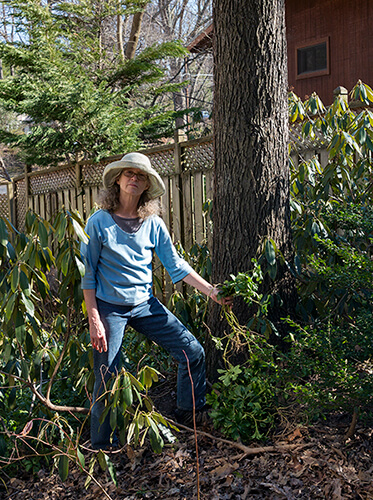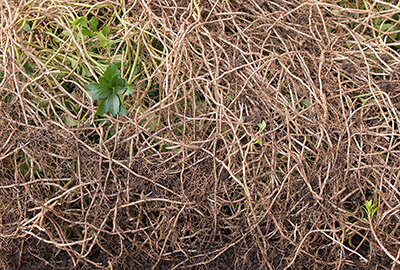DID THE PACHYSANDRA KILL THE HICKORY TREE?
by Joan Gottlieb
In my yard there is a large bed of Japanese spurge (Pachysandra terminalis), a plant widely used in landscaping. This hardy evergreen ground cover spreads by rhizomes to create what some proponents consider a “dependable green carpet.” If allowed to escape, it will cover a large area with a Pachysandra monoculture. Since my bed is contained, I wasn’t worried about the spreading. Although a bed of native plants would surely provide better habitat, the Pachysandra seemed a relatively benign bit of greenery. Its removal was not my priority. Until recently…
Within this bed, surrounded by the Pachysandra, there’s a mature hickory tree that didn’t leaf out fully last summer. Each branch showed signs of stress with small, sparse leaves. Many branches had areas with no leaves at all. I consulted an arborist who had no explanation for the decline but suggested a fertilizer treatment be applied in the spring. Hmmm.

UNPLEASANT SURPRISE
Over the winter, I began the long ignored task of Pachysandra removal, partly to allow inspection of the tree base, but also because it really was the right thing to do. The Japanese spurge was very easy to pull by hand from the soft, humus-rich soil. But what my pulling unveiled was a deep network of tangled roots that had buried the hickory’s root flare and smothered it with layers of moist debris.
Removing the evergreen Japanese spurge revealed rotting bark.
Sadly, the entire circumference of the tree’s base was now spongy decaying bark – bark that would otherwise protect the tree itself.


I do not yet know if the tree can be saved. Did my negligence allow the Pachysandra to kill the hickory tree?
Information about the homicide suspect can be found through Pennsylvania DCNR: Invasive Plants in Pennsylvania.
A discussion of its use in landscaping is here, but I do not advise using Pachysandra terminalis at all.
